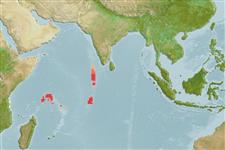>
Gobiiformes (Gobies) >
Gobiidae (Gobies) > Gobiinae
Etymology: Stonogobiops: Greek, stonos, -ou = groan + Latin, gobius = gudgeon + Greek, ops = appearance (Ref. 45335).
Environment: milieu / climate zone / depth range / distribution range
Ökologie
seewasser riff-verbunden; tiefenbereich 15 - 37 m (Ref. 9360), usually 20 - ? m (Ref. 30404). Tropical; 10°N - 10°S
Western Indian Ocean: Seychelles, Maldives.
Size / Gewicht / Alter
Maturity: Lm ? range ? - ? cm
Max length : 7.0 cm TL Männchen/unbestimmt; (Ref. 30404)
Rückenflossenstacheln (insgesamt): 7; Rückenflossenweichstrahlen (insgesamt): 10; Afterflossenstacheln 1; Afterflossenweichstrahlen: 9; Wirbelzahl: 26. Eyes and mouth large. Head yellow anteriorly and dorsally, white posteriorly; broad, diagonal bar from ventroposterior part of head to nape; 5 head pores. White interspaces on body bisected by orange-red line. First dark bar of body continued into the first, round dorsal fin; 2nd dorsal, anal and caudal fins pale whitish. Pectoral fins pointed. No scales on thorax and pectoral base. Angle of jaws 35 degrees. Palatines with tooth-like processes. Longitudinal scale series 84-94, transverse 26-32. Naked median predorsal region.
Inhabits open sand and rubble zones adjacent to reefs (Ref. 30404). Occurs in pairs and hovers above the burrow entrance. Lives symbiotically with Alpheus randalli (Ref. 9360).
Life cycle and mating behavior
Geschlechtsreife | Fortpflanzung | Ablaichen | Eier | Fecundity | Larven
Hoese, D.F. and J.E. Randall, 1982. Revision of the Indo-Pacific gobiid fish genus Stonogobiops. Indo-Pac. Fish. (1):18 p. (Ref. 397)
IUCN Rote Liste Status (Ref. 130435)
Bedrohung für Menschen
Harmless
Nutzung durch Menschen
Mehr Information
NamenSynonymeMetabolismusRäuberÖkotoxikologieFortpflanzungGeschlechtsreifeAblaichenSpawning aggregationFecundityEierEientwicklung
ReferenzenAquakulturAquakultur ProfilZuchtlinienGenetikElectrophoresesVererbbarkeitKrankheitenVerarbeitungNutrientsMass conversion
Tools
Zusatzinformationen
Download XML
Internet Quellen
Estimates based on models
Preferred temperature (Ref.
123201): 20 - 28.2, mean 27.6 °C (based on 8 cells).
Phylogenetic diversity index (Ref.
82804): PD
50 = 0.5078 [Uniqueness, from 0.5 = low to 2.0 = high].
Bayesian length-weight: a=0.01023 (0.00477 - 0.02194), b=3.02 (2.84 - 3.20), in cm total length, based on LWR estimates for this (Sub)family-body shape (Ref.
93245).
Trophic level (Ref.
69278): 3.2 ±0.3 se; based on size and trophs of closest relatives
Widerstandsfähigkeit (Ref.
120179): hoch, Verdopplung der Population dauert weniger als 15 Monate. (Preliminary K or Fecundity.).
Fishing Vulnerability (Ref.
59153): Low vulnerability (10 of 100).
